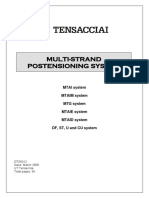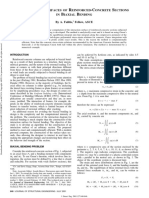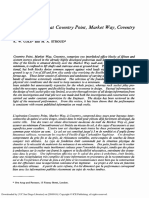Bridge Design To Eurocodes: UK Implementation
Bridge Design To Eurocodes: UK Implementation
Uploaded by
abbaszkCopyright:
Available Formats
Bridge Design To Eurocodes: UK Implementation
Bridge Design To Eurocodes: UK Implementation
Uploaded by
abbaszkOriginal Description:
Original Title
Copyright
Available Formats
Share this document
Did you find this document useful?
Is this content inappropriate?
Copyright:
Available Formats
Bridge Design To Eurocodes: UK Implementation
Bridge Design To Eurocodes: UK Implementation
Uploaded by
abbaszkCopyright:
Available Formats
22 -
23 November, 2010
Institution of Civil Engineers
UK NA to BS EN 1991-1-4 Wind Actions &
UK NA to BS EN 1991-1-5 Thermal Actions
Bridge Design to Eurocodes
UK Implementation
22 -
23 November, 2010
Institution of Civil Engineers
UK NA to BS EN 1991-1-4 Wind Actions
John Rees, Flint & Neill
Documents:
Documents:
What does EN1991-1-4 etc replace?
BS 6399: Part 2 (UK Head Wind Loading Code)
BS 5400: Part 2 (Wind parameters)
BD 37/01 (Wind parameters)
BD 49/01
Wind Maps
V
10-min
= 1.06 x V
hourly-mean
Differences in wind speed:
Gust wind speeds
V
hourly-mean
V
10-min mean
V
1
-
s
e
c
g
u
s
t
BS
EN
V
gust
= V
mean
+ gust peak factor x turbulence intensity
Applicability
Calculation of response - along wind
Criteria:
EN1991-1-4: Span < 40m
UK NA to EN1991-1-4: Span < 200m
Method:
EN1991-1-4
Annex B
Calculation of response - vertical
Criteria:
f
bending
& f
torsion
> 1Hz
or
|
|
.
|
\
|
|
|
.
|
\
|
=
m
b
b n
) z ( v
) z ( P
2
2
b
m
0 . 1
b
) z ( P
c
fm
s
o
o
Aerodynamic stability
|
.
|
\
|
=
L
b 16
) z ( P P
b
a)
P
b
< 0.04
Risk is insignificant
b)
0.04
P
b
1.00
Assess by calculation
c)
P
b
> 1.00
Investigate with wind tunnel testing
Refer to: PD 6688-1-4: Annex A
Simplified Method
x , ref
2
b W
A . C . v . .
2
1
F =
x , f e
c ). z ( c C =
Exposure Factor, c
e
(z)
Comparison of drag co-efficients
From EN1991-1-4: Figure 8.3
Values of C
22 -
23 November, 2010
Institution of Civil Engineers
UK NA to BS EN 1991-1-5 Thermal Actions
Tony Harris Parsons Brinckerhoff
Documents:
Documents:
What does EN1991-1-5 etc replace?
BS 5400: Part 2, Specification for loads, Section 5.4
BD 37/01, Loads for Highway Bridges
Representation of thermal actions
Important components for bridges:
Representation of thermal actions
Important components for bridges:
Representation of thermal actions
Important components for bridges:
Representation of thermal actions
Thermal Actions
Two distinct actions:
Uniform Temperature Component (clause 6.1.3)
(Effective bridge temperature in BD 37)
Thermal Actions
Two distinct actions:
Uniform Temperature Component (clause 6.1.3)
(Effective bridge temperature in BD 37)
Temperature Difference Component (clause 6.1.4)
Thermal Actions
AL
Uniform Temperature Component
(Shade Air Temperature
change in length)
Thermal Actions
AL
Uniform Temperature Component
(Shade Air Temperature
change in length)
Thermal Actions
AL
Uniform Temperature Component
(Shade Air Temperature
change in length)
Temperature Difference Component
(Solar Radiation
change in curvature)
Au
Thermal Actions
Bridge Deck Types
Three bridge deck types:
Type 1
steel box/plate girder or truss
Type 2
Composite
Type 3
Concrete slab/beam/box
Bridge Deck Types
Other deck types :
Buried concrete box and portal
frame structures (previously
covered within BD 31/01)
Masonry arch bridges with solid
spandrels (previously covered
within BD 91/04)
Common approach adopted,
more closely aligned to BD
91/04
Shade air temperatures
50 year return period data
Based on update to previous
(unadjusted) BS 5400 data
Validated by limited Met Office
study
Uniform Temperature Component
T
min
and T
max
are derived from maps
of isotherms found in Figure NA.1 of
the National Annex
T
e,min
and T
e,max
are derived from
min. and max. shade air
temperatures (T
min
and T
max
)
Temperature Difference Component
Two approaches within EN 1991-1-5
The National Annex requires Approach 2 to be used.
Same poly-linear heating (positive) and cooling
(reverse) distributions of temperature through deck
depth as BS 5400-2 with adjustments for surfacing
thickness.
Simultaneity
T
o
T
e,max
T
e,min
25
o
forType1
15
o
forTypes2&3
(T
e,max
8
o
)forType1
(T
e,max
4
o
)forType2
(T
e,max
2
o
)forType3
Heating Temperature
Difference
Cooling Temperature
Difference
Simultaneity
NA to be revised
Two options available:
Simultaneity
NA to be revised
Two options available:
1.
Retain BS 5400 provision
T
o
T
e,max
T
e,min
25
o
forType1
15
o
forTypes2&3
(T
e,max
8
o
)forType1
(Te,max 4
o
)forType2
(T
e,max
2
o
)forType3
HeatingTemperature
Difference
CoolingTemperature
Difference
Simultaneity
NA to be revised
Two options available:
1.
Retain BS 5400 provision
2.
Simplified approach
T
o
T
e,max
T
e,min
25
o
forType1
15
o
forTypes2&3
(T
e,max
8
o
)forType1
(Te,max 4
o
)forType2
(T
e,max
2
o
)forType3
HeatingTemperature
Difference
CoolingTemperature
Difference
T
o
T
e,max
T
e,min
HeatingTemperature
Difference
CoolingTemperature
Difference
Expansion Contraction
You might also like
- IRC-112-2011 & BS-EN-1992-2 (Provisions For Bearing Stress Check) Design Resistance (F)No ratings yetIRC-112-2011 & BS-EN-1992-2 (Provisions For Bearing Stress Check) Design Resistance (F)3 pages
- 447 2006 - The European en 1337 On Structural BearingsNo ratings yet447 2006 - The European en 1337 On Structural Bearings21 pages
- Vol.1 - 34 - How To Input Temperature Gradient Load For A General or PSC SectionNo ratings yetVol.1 - 34 - How To Input Temperature Gradient Load For A General or PSC Section1 page
- IRS-T-12 - 2009 With A & C 1, 2, 3 & 4 Specifications For Flat Bottom Rails PDFNo ratings yetIRS-T-12 - 2009 With A & C 1, 2, 3 & 4 Specifications For Flat Bottom Rails PDF93 pages
- Technical Improvements in en 1993 - Chris HendyNo ratings yetTechnical Improvements in en 1993 - Chris Hendy34 pages
- Webinar FX Supartono Aerodynamic 2021-06-03No ratings yetWebinar FX Supartono Aerodynamic 2021-06-03136 pages
- Pendel Bearing Replacement at A9 Kessock Bridge, Scotland 2007No ratings yetPendel Bearing Replacement at A9 Kessock Bridge, Scotland 20079 pages
- Flowchart of Reinforcement Concrete Design in Eurocode 2No ratings yetFlowchart of Reinforcement Concrete Design in Eurocode 291 pages
- 2001 - Interaction Surfaces of Reinforced-Concrete Sections in Biaxial BendingNo ratings yet2001 - Interaction Surfaces of Reinforced-Concrete Sections in Biaxial Bending7 pages
- Walter Podolny, JR.: A Legacy in Prestressed ConcreteNo ratings yetWalter Podolny, JR.: A Legacy in Prestressed Concrete3 pages
- General Notes Standard Precast Concrete Box Culvert: SheetNo ratings yetGeneral Notes Standard Precast Concrete Box Culvert: Sheet30 pages
- 03 12 General Design Design of Integral Bridges PDFNo ratings yet03 12 General Design Design of Integral Bridges PDF15 pages
- Vdocuments - MX - Bef Analogy For Concrete Box Girder Analysis of Bridges SummaryNo ratings yetVdocuments - MX - Bef Analogy For Concrete Box Girder Analysis of Bridges Summary8 pages
- Rock Socket Piles at Coventry Point, Market Way, CoventryNo ratings yetRock Socket Piles at Coventry Point, Market Way, Coventry16 pages
- ETA 19 0556 HSL 4 11 2022 Approval Document ASSET DOC 11738371No ratings yetETA 19 0556 HSL 4 11 2022 Approval Document ASSET DOC 1173837159 pages
- (PATEL) Shock Transmission Units For Earthquake Load Distribution100% (2)(PATEL) Shock Transmission Units For Earthquake Load Distribution17 pages
- Precast-Prestressed Concrete I-Beam BridgesNo ratings yetPrecast-Prestressed Concrete I-Beam Bridges10 pages
- Bridge Deck Analysis 2nd Edition Eugene J O'Brien All Chapters Instant Download100% (9)Bridge Deck Analysis 2nd Edition Eugene J O'Brien All Chapters Instant Download50 pages
- StressHead Technical Documentation en 160318No ratings yetStressHead Technical Documentation en 16031826 pages
- Dsi Usa Dywidag Bonded Post Tensioning Systems Us PDFNo ratings yetDsi Usa Dywidag Bonded Post Tensioning Systems Us PDF32 pages
- Imperfection Concept - SOFiSTiK TUTORiALSNo ratings yetImperfection Concept - SOFiSTiK TUTORiALS18 pages
- D101 - Braking and Acceleration Forces On Bridges and Interaction Between Track and StructuresNo ratings yetD101 - Braking and Acceleration Forces On Bridges and Interaction Between Track and Structures3 pages
- Science Reviewer Layer of The AtmosphereNo ratings yetScience Reviewer Layer of The Atmosphere6 pages
- Perceived Indoor Environmental Quality of Hospital Wards and Patients' Outcomes: A Study of A General Hospital, Minna, NigeriaNo ratings yetPerceived Indoor Environmental Quality of Hospital Wards and Patients' Outcomes: A Study of A General Hospital, Minna, Nigeria26 pages
- Project ON Forest & Desert Ecosystem: BY N.S.SwethaNo ratings yetProject ON Forest & Desert Ecosystem: BY N.S.Swetha14 pages
- Natural Hazards, Mitigation and Adaptation: Hydro Meteorological Phenomenon and HazardsNo ratings yetNatural Hazards, Mitigation and Adaptation: Hydro Meteorological Phenomenon and Hazards32 pages
- Get Extreme Wildfire Events and Disasters: Root Causes and New Management Strategies 1st Edition Fantina Tedim Free All Chapters100% (3)Get Extreme Wildfire Events and Disasters: Root Causes and New Management Strategies 1st Edition Fantina Tedim Free All Chapters62 pages
- WILP BITS-Pilani Probability and Statistics (SEWPZC213)No ratings yetWILP BITS-Pilani Probability and Statistics (SEWPZC213)28 pages
- GR 9 Geog Book Exercise CH 2 Physical Features of IndiaNo ratings yetGR 9 Geog Book Exercise CH 2 Physical Features of India7 pages
- Environmental Gradients, Tolerance and Adaptation, Threats To The Environment100% (1)Environmental Gradients, Tolerance and Adaptation, Threats To The Environment47 pages
- Natural Resources: Vital & Invaluable: Subject: Environmental Studies Lecturer: Eng. Ahmad Fawad EhsasNo ratings yetNatural Resources: Vital & Invaluable: Subject: Environmental Studies Lecturer: Eng. Ahmad Fawad Ehsas42 pages
- Cooling Water Inlet Tem-Perature at Scavenge Air Cooler: Service Letter SL2014-589/MTSNo ratings yetCooling Water Inlet Tem-Perature at Scavenge Air Cooler: Service Letter SL2014-589/MTS2 pages
- The Benefits of Utilizing Series Counterflow Variable Speed Screw ChillersNo ratings yetThe Benefits of Utilizing Series Counterflow Variable Speed Screw Chillers11 pages
- IRC-112-2011 & BS-EN-1992-2 (Provisions For Bearing Stress Check) Design Resistance (F)IRC-112-2011 & BS-EN-1992-2 (Provisions For Bearing Stress Check) Design Resistance (F)
- 447 2006 - The European en 1337 On Structural Bearings447 2006 - The European en 1337 On Structural Bearings
- Vol.1 - 34 - How To Input Temperature Gradient Load For A General or PSC SectionVol.1 - 34 - How To Input Temperature Gradient Load For A General or PSC Section
- IRS-T-12 - 2009 With A & C 1, 2, 3 & 4 Specifications For Flat Bottom Rails PDFIRS-T-12 - 2009 With A & C 1, 2, 3 & 4 Specifications For Flat Bottom Rails PDF
- Pendel Bearing Replacement at A9 Kessock Bridge, Scotland 2007Pendel Bearing Replacement at A9 Kessock Bridge, Scotland 2007
- Flowchart of Reinforcement Concrete Design in Eurocode 2Flowchart of Reinforcement Concrete Design in Eurocode 2
- 2001 - Interaction Surfaces of Reinforced-Concrete Sections in Biaxial Bending2001 - Interaction Surfaces of Reinforced-Concrete Sections in Biaxial Bending
- Walter Podolny, JR.: A Legacy in Prestressed ConcreteWalter Podolny, JR.: A Legacy in Prestressed Concrete
- General Notes Standard Precast Concrete Box Culvert: SheetGeneral Notes Standard Precast Concrete Box Culvert: Sheet
- 03 12 General Design Design of Integral Bridges PDF03 12 General Design Design of Integral Bridges PDF
- Vdocuments - MX - Bef Analogy For Concrete Box Girder Analysis of Bridges SummaryVdocuments - MX - Bef Analogy For Concrete Box Girder Analysis of Bridges Summary
- Rock Socket Piles at Coventry Point, Market Way, CoventryRock Socket Piles at Coventry Point, Market Way, Coventry
- ETA 19 0556 HSL 4 11 2022 Approval Document ASSET DOC 11738371ETA 19 0556 HSL 4 11 2022 Approval Document ASSET DOC 11738371
- (PATEL) Shock Transmission Units For Earthquake Load Distribution(PATEL) Shock Transmission Units For Earthquake Load Distribution
- Bridge Deck Analysis 2nd Edition Eugene J O'Brien All Chapters Instant DownloadBridge Deck Analysis 2nd Edition Eugene J O'Brien All Chapters Instant Download
- Dsi Usa Dywidag Bonded Post Tensioning Systems Us PDFDsi Usa Dywidag Bonded Post Tensioning Systems Us PDF
- D101 - Braking and Acceleration Forces On Bridges and Interaction Between Track and StructuresD101 - Braking and Acceleration Forces On Bridges and Interaction Between Track and Structures
- Perceived Indoor Environmental Quality of Hospital Wards and Patients' Outcomes: A Study of A General Hospital, Minna, NigeriaPerceived Indoor Environmental Quality of Hospital Wards and Patients' Outcomes: A Study of A General Hospital, Minna, Nigeria
- Project ON Forest & Desert Ecosystem: BY N.S.SwethaProject ON Forest & Desert Ecosystem: BY N.S.Swetha
- Natural Hazards, Mitigation and Adaptation: Hydro Meteorological Phenomenon and HazardsNatural Hazards, Mitigation and Adaptation: Hydro Meteorological Phenomenon and Hazards
- Get Extreme Wildfire Events and Disasters: Root Causes and New Management Strategies 1st Edition Fantina Tedim Free All ChaptersGet Extreme Wildfire Events and Disasters: Root Causes and New Management Strategies 1st Edition Fantina Tedim Free All Chapters
- WILP BITS-Pilani Probability and Statistics (SEWPZC213)WILP BITS-Pilani Probability and Statistics (SEWPZC213)
- GR 9 Geog Book Exercise CH 2 Physical Features of IndiaGR 9 Geog Book Exercise CH 2 Physical Features of India
- Environmental Gradients, Tolerance and Adaptation, Threats To The EnvironmentEnvironmental Gradients, Tolerance and Adaptation, Threats To The Environment
- Natural Resources: Vital & Invaluable: Subject: Environmental Studies Lecturer: Eng. Ahmad Fawad EhsasNatural Resources: Vital & Invaluable: Subject: Environmental Studies Lecturer: Eng. Ahmad Fawad Ehsas
- Cooling Water Inlet Tem-Perature at Scavenge Air Cooler: Service Letter SL2014-589/MTSCooling Water Inlet Tem-Perature at Scavenge Air Cooler: Service Letter SL2014-589/MTS
- The Benefits of Utilizing Series Counterflow Variable Speed Screw ChillersThe Benefits of Utilizing Series Counterflow Variable Speed Screw Chillers

























































































